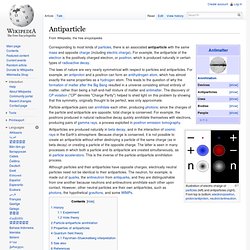

Richard Feynman. Antiparticle. The laws of nature are very nearly symmetrical with respect to particles and antiparticles.

For example, an antiproton and a positron can form an antihydrogen atom, which has almost exactly the same properties as a hydrogen atom. This leads to the question of why the formation of matter after the Big Bang resulted in a universe consisting almost entirely of matter, rather than being a half-and-half mixture of matter and antimatter. The discovery of CP violation ("CP" denotes "Charge Parity") helped to shed light on this problem by showing that this symmetry, originally thought to be perfect, was only approximate. Particle-antiparticle pairs can annihilate each other, producing photons; since the charges of the particle and antiparticle are opposite, total charge is conserved. For example, the positrons produced in natural radioactive decay quickly annihilate themselves with electrons, producing pairs of gamma rays, a process exploited in positron emission tomography. Feynman diagram. In theoretical physics, Feynman diagrams are pictorial representations of the mathematical expressions governing the behavior of subatomic particles.

The scheme is named for its inventor, Nobel Prize-winning American physicist Richard Feynman, and was first introduced in 1948. The interaction of sub-atomic particles can be complex and difficult to understand intuitively, and the Feynman diagrams allow for a simple visualization of what would otherwise be a rather arcane and abstract formula. As David Kaiser writes, "since the middle of the 20th century, theoretical physicists have increasingly turned to this tool to help them undertake critical calculations", and as such "Feynman diagrams have revolutionized nearly every aspect of theoretical physics".[1] While the diagrams are applied primarily to quantum field theory, they can also be used in other fields, such as solid-state theory. Motivation and history[edit]